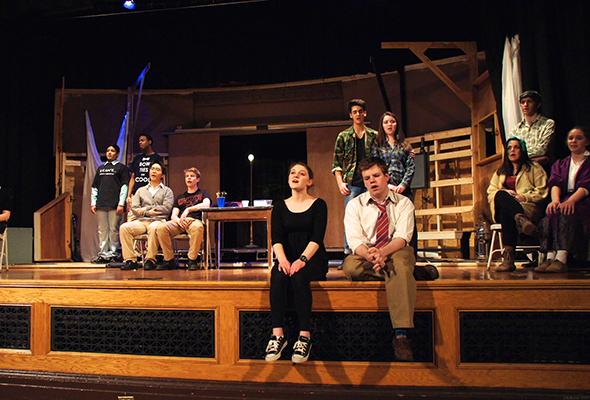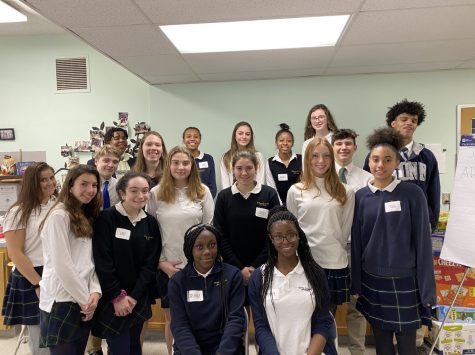Laughing Stock: Escaping the Winter Doldrums

March 11, 2015
This past weekend, on March 6th and 7th, the Albany Academies community was treated to a riveting performance of this year’s school play, Laughing Stock. Set in New Hampshire at a rustic summer theatre called The Playhouse, Laughing Stock provides a humorous and honest look at the world of theater. Three times Laughing Stock operates as a play-within-a-play, revealing the inner workings of dysfunctional productions of Dracula, Hamlet, and Charley’s Aunt. Rather than simply focusing on the final product of the rehearsal process – the show itself – the play focuses on all that goes into a production behind the scenes, including financial troubles, attitude problems, and tensions between actors and technicians.
The audience is introduced to The Playhouse actors in the opening scenes, which feature the auditions for The Playhouse. Each actor demonstrates a particular stereotype in the theater world. There’s Jack Morris (Max Collura ’18), a bright, young, promising actor who is leaving the business to pursue a career in law. Peter Cho ’16 plays Vernon Volker, a pretentious and critical actor jaded by his 30 years of experience in the field. Arian Baghaei-Rad ’16 steals the show as the self-centered, womanizing Tyler Taylor. Colleen Roohan ’16 plays the impressionable, boy-crazy Mary Pierre. We are also introduced to the longtime members of The Playhouse, Daisy Coates (Sarah Allen ’16) and Richfield Hawksley (Kammeron Filanova ’15). The technical side to every production is demonstrated by characters such as Gordon Page, the overly ambitious Artistic Director at The Playhouse played by Kevin Rider ‘16. Madeleine Cavallino ’17 is the penny-pinching, self-titled Producing Executive Administrative Director, Craig. Julia Randall ’15 plays Sarah McKay, the bitter and sarcastic Stage Manager and recovering alcoholic. Sonya Rio-Glick ’15 plays the sassy set designer, Henri Mills.
Tensions run high as the actors and Gordon Page battle over the artistic vision of the productions while accounting for significant budget cuts. While Gordon and his actors demand extravagant set pieces and special effects, Craig and Henri fight them every step of the way. Many scenes in the play involve the entire cast onstage, and the focus of the play shifts from conversation to conversation seamlessly. The play provides plenty of slapstick comedy throughout the show, especially when the theatre begins its productions. The plays are filled with mishaps, ranging from faulty lighting, forgotten props and lines, wrong entrances, and outlandish acting.
After the difficult (yet hilarious) run experienced by all at The Playhouse, the play ends on a heartfelt note. Sarah McKay acknowledges that the theater helps everyone involved with it create “another little temporary family.” The play ends with the entire cast joining together in singing Auld Lang Syne, a Playhouse tradition. Playwright Charles Morey wanted to evoke a universal type of nostalgia that any audience can appreciate: “Everyone in the theatre has his or her own ‘Playhouse,’ the place where there was never enough of anything: time, staff, money, and sometimes simply not enough talent or skill… but where you gave yourself over wholly to the making of plays, to telling stories in the dark on a summer night and along the way made a little family as well for a few months.” The earnestness of the characters as they navigate their personal, professional, and love lives is relatable to every member of the audience.
Each member of the cast and crew performed at the top of their game, delivering a thrilling and highly entertaining performance. Every scene in the play was greeted with enthusiastic laughter from the audience. Even those in the audience who weren’t theater insiders still enjoyed the humor and loved the play. Congratulations to all cast and crew members of Laughing Stock for an incredible show!




